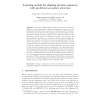24 search results - page 2 / 5 » GASP: Gapped Ancestral Sequence Prediction for proteins |
RECOMB
2009
Springer
14 years 5 months ago
2009
Springer
Accurately aligning distant protein sequences is notoriously difficult. A recent approach to improving alignment accuracy is to use additional information such as predicted seconda...
BMCBI
2006
13 years 4 months ago
2006
Background: When accurate models for the divergent evolution of protein sequences are integrated with complementary biological information, such as folded protein structures, anal...
BMCBI
2011
12 years 12 months ago
2011
Background: The accurate determination of orthology and inparalogy relationships is essential for comparative sequence analysis, functional gene annotation and evolutionary studie...
BMCBI
2005
13 years 4 months ago
2005
Background: The large gap between the number of protein sequences in databases and the number of functionally characterized proteins calls for the development of a fast computatio...
BMCBI
2008
13 years 5 months ago
2008
Background: We present a novel method of protein fold decoy discrimination using machine learning, more specifically using neural networks. Here, decoy discrimination is represent...

